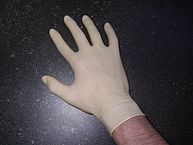Recently, the BBC reported that an 800-year old coffin at the Prittlewell Priory Museum in England was damaged when parents placed their small child into the coffin for a photograph. Although repairable, the damage to the coffin is serious, and highlights the importance in paying attention to obeying barriers and other protective measures.
However, not all protective measures are actually helpful, and some may be actively harmful! The dreaded-by-some, beloved-by-others white cotton gloves are one of these harmful measures. Although white gloves are a stereotypical symbol of the dedicated archivist and conservator, they are no longer used and for good reason.
HSP’s Director of Conservation and Preservation Tara O’Brien explains: “It is better if one does not wear gloves but handles documents with freshly washed and dried hands (no lotion). Your fingertips are incredibly sensitive. They can feel the edge of the paper, they can feel the weight of the paper, and can even sense how paper will behave if you try to turn a page. That sensitivity is blocked when wearing gloves. Brittle edges of paper can snag easily on the any loose fibers of the gloves without the wearer even noticing.”
We are used to depictions of a researcher wearing white gloves to protect priceless documents as he (it is usually a he) pages through treasures to find some needed scrap of information. The common knowledge is that the documents must be protected from the damaging oils and acids on the skin of the hands. This common knowledge, though, ignores that many of these documents were handled for centuries before being placed into a museum or archives. If they were going to be damaged by human touch it would have happened well before the time of our researcher. As explained by HSP’s conservator, the most careful handling results from taking advantage of how sensitive fingertips are. Clean, dry hands will certainly be clean enough to protect documents and books.
Not every object can be handled without protection, of course. Photographs, in particular, really are vulnerable to the pH of human skin. In that case, though, white cotton gloves are still a poor choice. They simply block too much sensation and information, in addition to vulnerable edges catching on the fabric. Tight-fitting nitrile or latex gloves are a far better choice, if one is handling objects that would be damaged by coming into contact with bare hands.
The impulse to protect the artifacts of the past is a good one, and this isn’t meant to discourage that. But be cautious in sticking to old standards: just because they’ve been around for a long time doesn’t mean they’re a good option!
